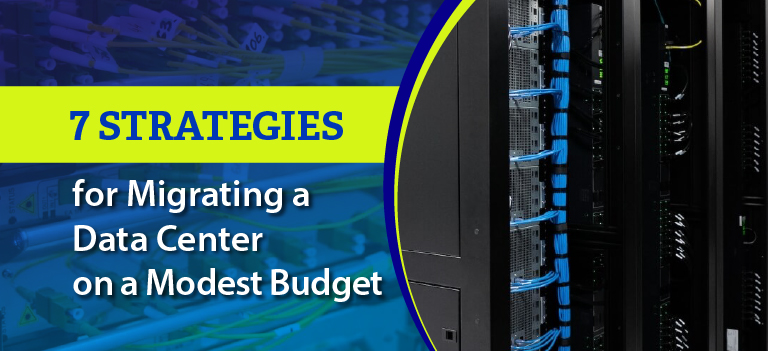Migrating data centers can give a growing business many advantages, including greater efficiency, reduced security risks and improved customer relationships. It’s often a necessary step in a business’s development, but it can be a significant financial burden.
Here are seven strategies to help organizations migrate their data centers on a modest budget.
1. Write a Moving Checklist
As with any migration project, the first step is to write a moving checklist. This checklist serves as the foundation for the rest of the migration process. It helps to ensure that no equipment gets misplaced or damaged during the move. It also helps businesses establish key performance indicators, contingency plans and compliance requirements to minimize their budget.
Deciding what to move is one of the biggest challenges of a data center migration, which is another reason why a moving checklist is so important. There’s always some risk involved with transporting heavy, fragile computer equipment. Some organizations purchase new equipment to simplify the relocation, but those expenses hike up the budget.
If getting new equipment is non-negotiable, it’s more cost-effective to lease new equipment instead of buying — at least in the short-term. Leasing allows organizations to convert a sizable capital expense into a more manageable operating expense. Leasing also allows businesses to scale up or down to meet their specific needs.
2. Set a Realistic Timeline
Once the moving checklist is complete, setting a realistic timeline is the next step. The length of data center migrations can widely vary depending on the number of servers that need to be moved. It’s crucial for businesses on modest budgets to set an accurate timeline. If they’re too ambitious, they could end up paying for steep overrun costs.
Risk management is the key to determining a realistic timeline. There’s almost a guarantee that something will go wrong during migration, so it’s important to account for various setbacks beforehand. Performing a thorough risk assessment is always cheaper than paying to mitigate risks after they cause a problem.
3. Perform a Final Equipment Inspection
Before relocating to the new data center, it’s crucial to perform one final equipment inspection and take photos of each item. Photographic evidence can be used as undeniable evidence of equipment damage that occurs during the move, which ensures that the organization’s insurance policy will cover the costs.
Tag everything that’s staying and everything that’s going. Write down the warranty information and serial number of every piece of equipment that’s going to the new data center. In some cases, a data center migration can void a server’s warranty. If the equipment gets damaged and it no longer has a warranty, the business will have to pay for the repairs or replacement.
4. Get Affordable Moving Vehicles
Once everything is ready for the migration, it’s time to find affordable moving vehicles. Look for moving services that provide gooseneck trailers in particular. These trailers have payload capacities of 14,000 to 25,000 pounds and are specifically designed to haul heavy machinery. They can also reach up to 40 feet long and fit more equipment than other trailers.
If there’s one expense that businesses should be willing to overspend on, it’s the moving service. Don’t settle for a regular rental service. Find a company that specializes in office technology and critical IT relocations. Spending extra to prevent equipment damage is better than the possibility of paying for equipment damage later on.
5. Map Out the Safest Route
Transporting equipment to the new data center isn’t as straightforward as it seems. Organizations must take their time mapping out the safest route. Try to eliminate as many narrow roads and tight turns as possible. Ideally, the route should primarily consist of wide streets with speed limits in the 35-55 mph range to minimize the risk of an accident.
It’s also important to give the drivers special instructions. Remind them to keep a defensive mindset and always leave themselves an escape route if a dangerous situation arises. It’s much easier for drivers transporting heavy payloads to react to traffic hazards when going at a moderate speed and keeping their eyes on the road.
6. Monitor the Installation Process
As the equipment gets unloaded, confirm that each item is undamaged and ready for installation. This step in the data center migration process is usually the most challenging, so close supervision is required. Perform frequent assessments throughout the installation to ensure every server is functioning properly.
It’s also important to document the installation process for future reference. When everything is over, businesses need to evaluate the migration’s success. Did it meet the predetermined budget, timeline and KPIs? What roadblocks did employees encounter when transitioning to the new facility? Leaving a paper trail makes it easier to discover and fix errors — particularly with payments.
7. Test the New Facility
Data migration is not complete once the new facility is up and running. Organizations still need to perform one last test, also known as a spot audit. Spot audits are effective strategies for holding the movers accountable and avoiding non-compliance with industry regulations.
A post-migration inspection also allows organizations to decommission any equipment that might not be cost-effective anymore.
Extra Precaution Saves Money
These seven money-saving strategies for data center migrations play vastly different roles, but they all have one thing in common — extra precaution.
Organizations on modest budgets can’t afford to be careless at any step in the migration process. Every detail must be documented and accounted for.
Oscar Collins


